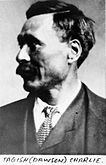


Discovery Claim is a mining claim at Bonanza Creek, a watercourse in the Yukon, Canada. It is the site where, in the afternoon of August 16, 1896, the first piece of gold was found in the Yukon by prospectors. The site is considered to be the place where the Klondike gold rush started. It is located around 17 kilometres (11 miles) south-southeast of Dawson City. The Discovery claim was designated a National Historic Site of Canada on July 13, 1998.



